
A crystallographic defect is an interruption of the regular patterns of arrangement of atoms or molecules in crystalline solids. The positions and orientations of particles, which are repeating at fixed distances determined by the unit cell parameters in crystals, exhibit a periodic crystal structure, but this is usually imperfect. Several types of defects are often characterized: point defects, line defects, planar defects, bulk defects. Topological homotopy establishes a mathematical method of characterization.
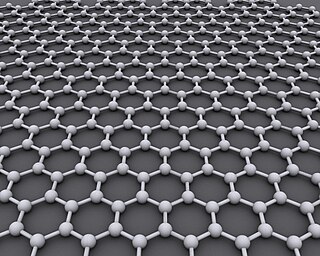
Graphene is an allotrope of carbon consisting of a single layer of atoms arranged in a hexagonal lattice nanostructure. The name is derived from "graphite" and the suffix -ene, reflecting the fact that the graphite allotrope of carbon contains numerous double bonds.
Quantum reflection is a uniquely quantum phenomenon in which an object, such as a neutron or a small molecule, reflects smoothly and in a wavelike fashion from a much larger surface, such as a pool of mercury. A classically behaving neutron or molecule will strike the same surface much like a thrown ball, hitting only at one atomic-scale location where it is either absorbed or scattered. Quantum reflection provides a powerful experimental demonstration of particle-wave duality, since it is the extended quantum wave packet of the particle, rather than the particle itself, that reflects from the larger surface. It is similar to reflection high-energy electron diffraction, where electrons reflect and diffraction from surfaces, and grazing incidence atom scattering, where the fact that atoms can also be waves is used to diffract from surfaces.
Surface reconstruction refers to the process by which atoms at the surface of a crystal assume a different structure than that of the bulk. Surface reconstructions are important in that they help in the understanding of surface chemistry for various materials, especially in the case where another material is adsorbed onto the surface.
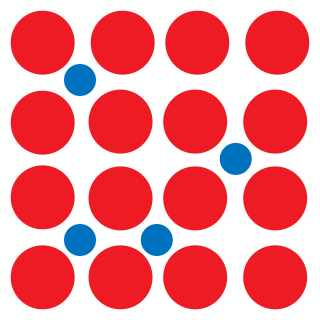
In materials science, an interstitial defect is a type of point crystallographic defect where an atom of the same or of a different type, occupies an interstitial site in the crystal structure. When the atom is of the same type as those already present they are known as a self-interstitial defect. Alternatively, small atoms in some crystals may occupy interstitial sites, such as hydrogen in palladium. Interstitials can be produced by bombarding a crystal with elementary particles having energy above the displacement threshold for that crystal, but they may also exist in small concentrations in thermodynamic equilibrium. The presence of interstitial defects can modify the physical and chemical properties of a material.

Graphene nanoribbons are strips of graphene with width less than 100 nm. Graphene ribbons were introduced as a theoretical model by Mitsutaka Fujita and coauthors to examine the edge and nanoscale size effect in graphene.
Stranski–Krastanov growth is one of the three primary modes by which thin films grow epitaxially at a crystal surface or interface. Also known as 'layer-plus-island growth', the SK mode follows a two step process: initially, complete films of adsorbates, up to several monolayers thick, grow in a layer-by-layer fashion on a crystal substrate. Beyond a critical layer thickness, which depends on strain and the chemical potential of the deposited film, growth continues through the nucleation and coalescence of adsorbate 'islands'. This growth mechanism was first noted by Ivan Stranski and Lyubomir Krastanov in 1938. It wasn't until 1958 however, in a seminal work by Ernst Bauer published in Zeitschrift für Kristallographie, that the SK, Volmer–Weber, and Frank–van der Merwe mechanisms were systematically classified as the primary thin-film growth processes. Since then, SK growth has been the subject of intense investigation, not only to better understand the complex thermodynamics and kinetics at the core of thin-film formation, but also as a route to fabricating novel nanostructures for application in the microelectronics industry.
Mitsutaka Fujita was a Japanese physicist. He proposed the edge state that is unique to graphene zigzag edges. Also, he theoretically pointed out the importance and peculiarity of nanoscale and edge shape effects in nanographene. The theoretical concept of graphene nanoribbons was introduced by him and his research group to study the nanoscale effect of graphene. He was an associate professor at Tsukuba University, and died of a subarachnoid hemorrhage on March 18, 1998. His posthumous name is Rikakuin-Shinju-Houkou-Koji (理覚院深珠放光居士) in Japanese.
In physics, the plasmaron was proposed by Lundqvist in 1967 as a quasiparticle arising in a system that has strong plasmon-electron interactions. In the original work, the plasmaron was proposed to describe a secondary peak in the photoemission spectral function of the electron gas. More precisely it was defined as an additional zero of the quasi-particle equation . The same authors pointed out, in a subsequent work, that this extra solution might be an artifact of the used approximations:
We want to stress again that the discussion we have given of the one-electron spectrum is based on the assumption that vertex corrections are small. As discussed in the next section recent work by Langreth [29] shows that vertex corrections in the core electron problem can have a quite large effect on the form of satellite structures, while their effect on the quasi particle properties seems to be small. Preliminary investigations by one of us (L.H.) show similar strong vertex effects on the conduction band satellite. The details of the plasmaron structure should thus not be taken very seriously.
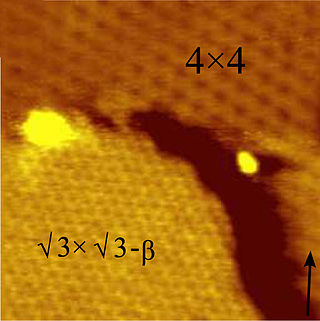
Silicene is a two-dimensional allotrope of silicon, with a hexagonal honeycomb structure similar to that of graphene. Contrary to graphene, silicene is not flat, but has a periodically buckled topology; the coupling between layers in silicene is much stronger than in multilayered graphene; and the oxidized form of silicene, 2D silica, has a very different chemical structure from graphene oxide.

Yeom Han-woong is a South Korean physicist. A tenured professor at POSTECH, he has led several research centers for the university and from 2013 in collaboration with the Institute for Basic Science. He is a Fellow of the American Physical Society and has served as vice chairman of the Korean government's first science and technology advisory group for three consecutive terms. With more than 300 publications to his name, his research has been cited over 5,000 times giving him an h-index of 40 and i10-index of 125.
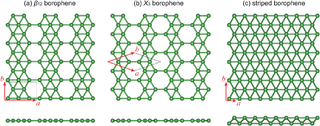
Borophene is a crystalline atomic monolayer of boron, i.e., it is a two-dimensional allotrope of boron and also known as boron sheet. First predicted by theory in the mid-1990s, different borophene structures were experimentally confirmed in 2015.
Valleytronics is an experimental area in semiconductors that exploits local extrema ("valleys") in the electronic band structure. Certain semiconductors have multiple "valleys" in the electronic band structure of the first Brillouin zone, and are known as multivalley semiconductors. Valleytronics is the technology of control over the valley degree of freedom, a local maximum/minimum on the valence/conduction band, of such multivalley semiconductors.

Germanene is a material made up of a single layer of germanium atoms. The material is created in a process similar to that of silicene and graphene, in which high vacuum and high temperature are used to deposit a layer of germanium atoms on a substrate. High-quality thin films of germanene have revealed unusual two-dimensional structures with novel electronic properties suitable for semiconductor device applications and materials science research.
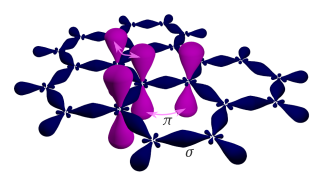
Graphene is a semimetal whose conduction and valence bands meet at the Dirac points, which are six locations in momentum space, the vertices of its hexagonal Brillouin zone, divided into two non-equivalent sets of three points. The two sets are labeled K and K'. The sets give graphene a valley degeneracy of gv = 2. By contrast, for traditional semiconductors the primary point of interest is generally Γ, where momentum is zero. Four electronic properties separate it from other condensed matter systems.

Single-layer graphene was first unambiguously produced and identified in 2004, by the group of Andre Geim and Konstantin Novoselov, though they credit Hanns-Peter Boehm and his co-workers for the experimental discovery of graphene in 1962; while it had been explored theoretically by P. R. Wallace in 1947. Boehm et al. introduced the term graphene in 1986.
Frank F. Fang is a Chinese-American solid-state physicist. He was part of the team that succeeded in 1966 in the detection of a two-dimensional electron gas and its quantum properties in semiconductors.

David Tománek (born July 1954) is a U.S.-Swiss physicist of Czech origin and researcher in nanoscience and nanotechnology. He is Emeritus Professor of Physics at Michigan State University. He is known for predicting the structure and calculating properties of surfaces, atomic clusters including the C60 buckminsterfullerene, nanotubes, nanowires and nanohelices, graphene, and two-dimensional materials including phosphorene.
Straintronics is the study of how folds and mechanically induced stresses in a layer of two-dimensional materials can change their electrical properties. It is distinct from twistronics in that the latter involves changes in the angle between two layers of 2D material. However, in such multi-layers if strain is applied to only one layers, which is called heterostrain, strain can have similar effect as twist in changing electronic properties. It is also distinct from, but similar to, the piezoelectric effects which are created by bending, twisting, or squeezing of certain material.
Allotropes of silicon are structurally varied forms of silicon.













